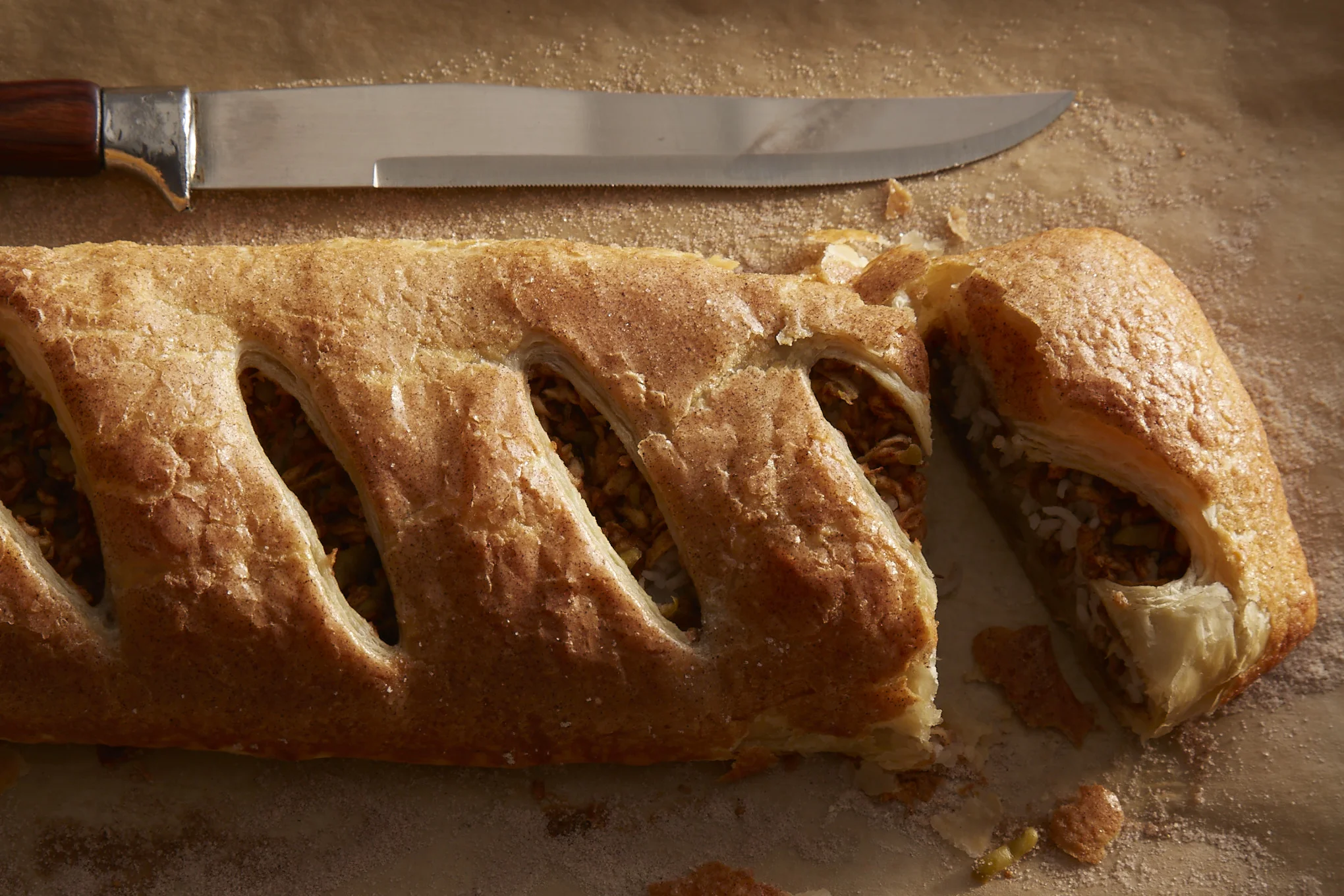A Simchat Torah Tradition That Was Nearly Lost
Shared by Ahuva Passow-Whitman
Recipe Roots: Galicia, Poland > New York City > Memphis > Tel Aviv > Jerusalem
Each year, before Simchat Torah, the fall holiday that marks the conclusion and restart of the reading of the Torah, Ahuva Passow-Whitman sends an email to her family. “I ask them to please make the kugel and keep the tradition alive,” she explains. The kugel she’s referring to is, in her own words, not precisely a kugel. It’s closer to a strudel, filled with apples and rice. And, it’s how the family has always marked the holiday, which is celebrated just after Sukkot.
The uncommon combination of apples and rice, Ahuva believes, likely has roots in Galicia, a region of Poland and Ukraine, where her mother’s family lived before immigrating to the United States. Twenty or so years ago, Ahuva asked the family’s last surviving relative from Poland if she recalled having this recipe in Perehensko, a town where the family was from that seems have to be erased from maps. It sounded familiar but she couldn’t be sure. “She and her late husband were on the run throughout the entire war,” Ahuva explains. “She said ‘so many things left my mind and my memory.’”
Ahuva (left) and her mother Clara (right), November 1981.
Regardless of the recipe’s provenance, it was a family tradition when Ahuva was growing up first in New York City, then when they moved to Memphis for a few years, and later in Israel where the family settled. It was served alongside stuffed cabbage for the holiday by her mother Clara. Born in the U.S. in 1914, Clara was a gifted cook and baker, even baking a five layer cake for Ahuva’s uncle’s wedding.
Clara grew her cooking repertoire by watching a television series with Dione Lucas, an English cook who was the first woman to graduate from Le Cordon Bleu. She shared her recipes and other homemaking tips on an English-language radio program on a Yiddish radio station in New York. And, when the family moved to Israel in 1959, Clara started to swap recipes with a Yemenite neighbor. “The two women were always exchanging recipes,” Ahuva recalls.
Ahuva learned to cook in the kitchen with her mother, but somehow never learned to make the Simchat Torah kugel when she was little. Thirty-five years ago, Ahuva says, “I realized as, my mother was dying, maybe three or four days before she passed away… it hit me that I don’t have a recipe for this kugel.”
Ahuva asked Clara to dictate the recipe to her. Well versed in dictating recipes from her days on the radio, her mother obliged: “That was the last thing I got from her — that legacy.”
Ahuva Passow-Whitman's Simchat Torah Strudel
Makes: 1 Strudel
Total time: 1 hour and 30 minutes
If you prefer a sweeter strudel you can use Pink Lady apples instead of Granny Smith apples.
Ingredients
¼ cup basmati rice
2 tablespoons kosher salt
3 Granny Smith apples
2 teaspoons cinnamon
5 teaspoons granulated sugar
1 package frozen puff pastry, thawed
1½ teaspoons canola oil
Preparation:
1. Preheat the oven to 350°F and line a rimmed baking sheet with parchment paper.
2. Bring a small pot of water with 2 tablespoons of salt to a boil over high heat, about 5 minutes.
3. While waiting for the water to boil, place the rice in a strainer and rinse with lukewarm water until the water runs clear, about 5 times.
4. Add the rice to the pot and stir a few times to prevent the rice from sticking to the bottom. Cook the rice until it rises to the top, about 6-8 minutes. The rice should be par-cooked. Drain and rinse with cold water. Set aside to cool.
5. Grate the apples with their skins into a colander, avoiding the apple core. Dispose the apple cores. Squeeze the excess liquid out of the grated apples and place them into a medium sized bowl. Place 1 teaspoon of cinnamon and 2 teaspoons of sugar on to the apples. Mix well until combined evenly.
6. Place one sheet of puff pastry onto a floured countertop surface. Roll out the dough evenly into a 12 inch by 16 inch rectangle. Place the sheet of dough in front of you horizontally, so the longer sides are closer to you. Trim ½ inch from all four edges of the sheet.
7. Brush ½ teaspoon of canola oil onto the rolled out sheet of dough. Sprinkle the rice evenly over the dough leaving a ½ inch border around the perimeter. Spread the apple mixture evenly over the rice. Evenly sprinkle another teaspoon of sugar and ½ teaspoon of cinnamon over the apples.
8. Brush a little bit of water on the long edges of the dough. Starting from the closest edge to you, roll up the rectangle like a roulade using both hands. Pinch the seam with your fingers and place seam-side of the strudel underneath. Use your hands to even out the strudel.
9. Gently place the strudel onto the parchment lined baking sheet. Brush 1 teaspoon of canola oil on top of the log. Sprinkle 1 teaspoon of sugar and ½ teaspoon of cinnamon evenly over the strudel. Using a sharp paring knife, cut 3 to 4 diagonal slits about 2-3 inches long evenly along the log. The slits will release the steam out of the strudel during baking.
10. Bake the strudel in the middle rack of the oven until it is golden brown on top, about 40 minutes. Serve hot.










